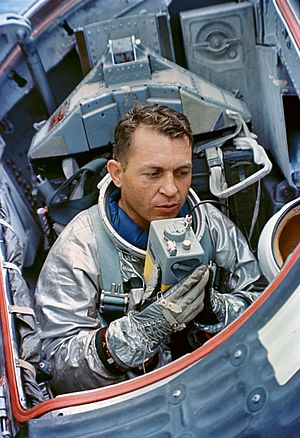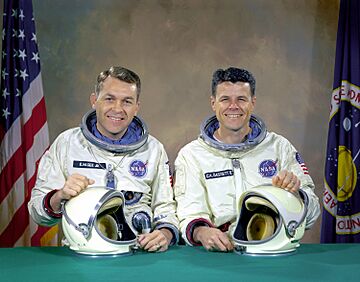Elliot See facts for kids
Quick facts for kids
Elliot See
|
|
|---|---|
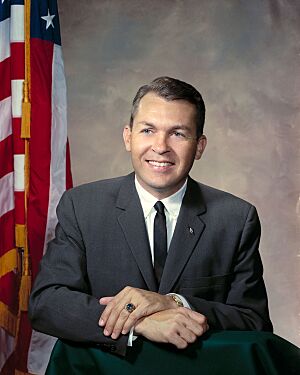
See in 1964
|
|
| Born |
Elliot McKay See Jr.
July 23, 1927 |
| Died | February 28, 1966 (aged 38) |
| Space career | |
| NASA astronaut | |
| Rank | Commander, USNR |
| Selection | 1962 NASA Group 2 |
Elliot McKay See Jr. (July 23, 1927 – February 28, 1966) was a brave American engineer, Navy pilot, and NASA astronaut. He was chosen for NASA's second group of astronauts in 1962.
Elliot See was set to be the main pilot for the Gemini 9 space mission. Sadly, he and his crewmate, Charles Bassett, died in a jet crash in St. Louis, Missouri. They were preparing for their space flight.
Contents
Elliot See's Early Life and School
Elliot McKay See Jr. was born in Dallas, Texas, on July 23, 1927. His father was an electrical engineer for General Electric. His mother worked in advertising and real estate. Elliot was active in the Boy Scouts of America for five years. He earned the highest rank, Eagle Scout.
He went to Highland Park High School. He played several sports, including boxing. He also joined the Reserve Officer Training Corps (ROTC) Rifle Team. He finished high school in 1945.
When World War II was ending, Elliot chose to go to college. He first attended the University of Texas. There, he took flying lessons and earned his private pilot's license.
In 1945, Elliot joined the United States Merchant Marine Academy (USMMA). This school trains officers for the merchant marine. He studied marine engineering and became a cadet officer. He was also a head cheerleader and played sports. In 1949, he earned his Bachelor of Science degree. He also became an officer in the Navy Reserve.
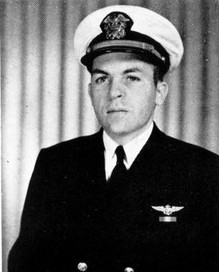
After graduating, Elliot See joined the Aircraft Gas Turbine Division of General Electric (GE). His father also worked for GE. In Cincinnati, Ohio, he met Marilyn Jane Denahy. She was a secretary at GE. They got married in 1954.
Elliot was called to active duty in the Navy during the Korean War. He became a naval aviator. He flew Grumman F9F Panther fighter jets. He served on the aircraft carrier USS Randolph in the Mediterranean Sea. Later, he served on USS Boxer in the Pacific Ocean. He became very good at landing jets on aircraft carriers. By the end of his Navy tour, he was a lieutenant commander.
In 1956, Elliot rejoined General Electric as a flight test engineer. He became a leader and test pilot at Edwards Air Force Base in California. There, he flew the newest jet aircraft with GE engines. He tested engines like the General Electric J79. He flew many different planes, including the F-86, F-104, and T-38.
While working, he also continued his education. In 1962, he earned a Master of Science degree in aeronautical engineering from UCLA. He also kept flying with the Naval Reserve. He was later promoted to commander.
Elliot See's NASA Career
In 1962, Elliot See applied to become a NASA astronaut. He was chosen for NASA's second group of astronauts, called The New Nine. He was 35 years old, the oldest in his group. He was very excited and honored to be selected. At that time, he had flown over 3,900 hours, mostly in jet aircraft.
Each astronaut at NASA was given a special area to become an expert in. Elliot See's area was the spacecraft's electrical and control systems. He also helped plan missions. He even flew helicopters and planes with special goggles. This helped him figure out the best lighting for landing on the Moon. He also practiced landing helicopters on lava flows. These flows looked like the Moon's surface.
On February 8, 1965, Elliot See was named the backup pilot for Gemini 5. Neil Armstrong was the backup command pilot. They were the first civilians chosen for a spaceflight. Gemini 5 launched on August 21, 1965. Early in the flight, there was a problem with the fuel cells. Mission controllers thought about ending the mission early. Elliot See had helped develop these fuel cells at General Electric. He was confident they could fix the problem. After working all night, they found a solution. This allowed the mission to continue.
Elliot See also worked as a capsule communicator (CAPCOM) during the Gemini 7/Gemini 6A mission in December 1965. This meant he was the voice on the radio talking to the astronauts in space.
Because he was the backup for Gemini 5, Elliot See was next in line for the main crew of Gemini 8. However, David Scott took his place. Elliot See was then promoted to command pilot for Gemini 9 in October 1965. Charles Bassett was chosen as his pilot. The Gemini 9 mission was planned to include a spacewalk. Bassett was scheduled for the spacewalk, and See would stay inside the capsule.
Tragic Accident and Legacy
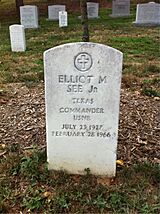
On February 28, 1966, Elliot See and Charles Bassett were flying to St. Louis, Missouri. They were going for two weeks of training for their space mission. They were flying a T-38 trainer jet. The weather was bad at the airport. On his second landing attempt, Elliot See's jet crashed into the McDonnell Aircraft Building 101. This was where the Gemini spacecraft was built.
Both astronauts died instantly in the accident. They were very close to their spacecraft. Elliot See and Charles Bassett were buried near each other at Arlington National Cemetery. Another astronaut, Theodore Freeman, who also died in a T-38 crash, is buried nearby.
After the accident, NASA created new rules to help families. Astronauts like John Young made sure that Elliot See's wife, Marilyn, heard the news from NASA first. Other astronaut wives helped comfort her and pick up her children from school.
A NASA investigation found that the bad weather and pilot error caused the crash. Elliot See was known as a very good pilot.
Because of the accident, the astronaut crews for future missions changed. Jim Lovell and Buzz Aldrin became the backup crew for Gemini 9. The original backup crew, Gene Cernan and Thomas Stafford, flew the mission three months later as Gemini 9A. These changes also affected later Project Apollo missions. For example, Buzz Aldrin flew on Gemini 12 and later on Apollo 11.
Elliot See was survived by his wife, Marilyn, and their three children. His name is on the Fallen Astronaut plaque placed on the Moon by Apollo 15 in 1971. His name is also on the Space Mirror Memorial at the John F. Kennedy Space Center Visitor Complex. In 2010, Highland Park High School honored him as a distinguished alumni. A room at the USMMA is also named in his memory.
See also
- Fallen Astronaut
- List of Eagle Scouts
- List of spaceflight-related accidents and incidents


